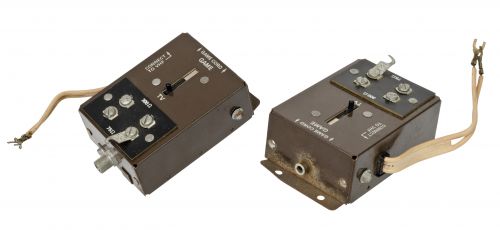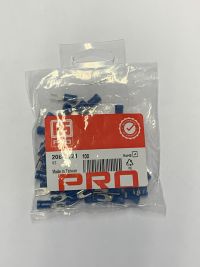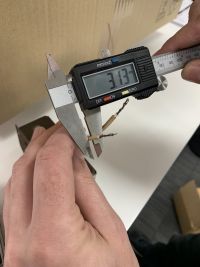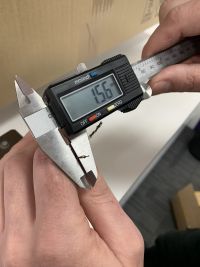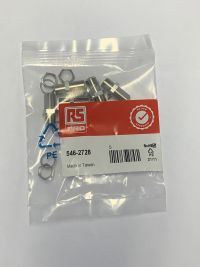Odyssey:Magnavox Odyssey Antenna-Game Switch: Difference between revisions
m (→Repairs) |
m (Text replacement - "[.][ ][ ]" to ". ") |
||
| (6 intermediate revisions by one other user not shown) | |||
| Line 1: | Line 1: | ||
The Antenna-Game Switch is a mechanical TV RF [https://www.best-electronics-ca.com/TV_sw.htm switch box], similar to models produced for a range of first and second generation consoles. Its purpose was to allow the user to select either the Odyssey or regular television viewings, without having to disturb their antenna connections. | The Antenna-Game Switch is a mechanical TV RF [https://www.best-electronics-ca.com/TV_sw.htm switch box], similar to models produced for a range of first and second generation consoles. Its purpose was to allow the user to select either the Odyssey or regular television viewings, without having to disturb their antenna connections. | ||
[[File:RF switchbox odyssey.jpg| | [[File:RF switchbox odyssey.jpg|500px]] | ||
==Operation== | ==Operation== | ||
| Line 7: | Line 7: | ||
The Game-Switch is connected to the main Odyssey console unit using the proprietary Game Cord. One end of the Game Cord is plugged into the Game Cord socket on the console, which the other end is plugged into the socket on the top of the Antenna-Game Switch marked Game Cord. | The Game-Switch is connected to the main Odyssey console unit using the proprietary Game Cord. One end of the Game Cord is plugged into the Game Cord socket on the console, which the other end is plugged into the socket on the top of the Antenna-Game Switch marked Game Cord. | ||
To send the console's video signal to the television, the Antenna-Game Switch | To send the console's video signal to the television, the Antenna-Game Switch outputs to a [https://en.wikipedia.org/wiki/Twin-lead twin-lead cable] attached to two fork connectors (also known as crimp spade connectors). | ||
These fork connectors would connect to screw-style VHF 300 Terminals on the back of the television. | |||
==Repairs== | ==Repairs== | ||
| Line 13: | Line 14: | ||
The most common damage to the Antenna-Game Switch is caused by rust, as the unit is made of metal. Additionally, the fork connectors are light and easily damaged. | The most common damage to the Antenna-Game Switch is caused by rust, as the unit is made of metal. Additionally, the fork connectors are light and easily damaged. | ||
Fortunately, replacement fork terminals | The Switch Box is held together by three 12mm Hex-Head screws (which can be removed with a 5-inch vise grip tool), and four 10mm flat-head screws (which can be removed with a screwdriver). | ||
Fortunately, replacement fork terminals are relatively easy to obtain, either uninsulated or insulated, [https://uk.rs-online.com/web/p/fork-terminals/2082521 as shown below]. | |||
The model of fork connectors shown below are "M3", which means that they will fit securely to an M3-sized screw. (Link > [https://www.fastenermart.com/understanding-metric-fasteners.html Detailed Explanation of Metric Fasteners]). | The model of fork connectors shown below are "M3", which means that they will fit securely to an M3-sized screw. (Link > [https://www.fastenermart.com/understanding-metric-fasteners.html Detailed Explanation of Metric Fasteners]). | ||
| Line 21: | Line 24: | ||
When selecting a replacement fork connector, the user should also consider the gauge of the original cables. | When selecting a replacement fork connector, the user should also consider the gauge of the original cables. | ||
The cables which need to be soldered to the fork connectors are approximately 3.13mm, and 1.56mm when the cable insulation is stripped back (see below). | The cables within the switch's [https://en.wikipedia.org/wiki/Twin-lead twin-lead], which need to be soldered to the fork connectors, are approximately 3.13mm including the insulation, and 1.56mm when the cable insulation is stripped back (see below). | ||
[[File:Switchbox cable 1.jpg|200px]] | [[File:Switchbox cable 1.jpg|200px]] | ||
Latest revision as of 04:47, 29 July 2022
The Antenna-Game Switch is a mechanical TV RF switch box, similar to models produced for a range of first and second generation consoles. Its purpose was to allow the user to select either the Odyssey or regular television viewings, without having to disturb their antenna connections.
Operation
The Game-Switch is connected to the main Odyssey console unit using the proprietary Game Cord. One end of the Game Cord is plugged into the Game Cord socket on the console, which the other end is plugged into the socket on the top of the Antenna-Game Switch marked Game Cord.
To send the console's video signal to the television, the Antenna-Game Switch outputs to a twin-lead cable attached to two fork connectors (also known as crimp spade connectors). These fork connectors would connect to screw-style VHF 300 Terminals on the back of the television.
Repairs
The most common damage to the Antenna-Game Switch is caused by rust, as the unit is made of metal. Additionally, the fork connectors are light and easily damaged.
The Switch Box is held together by three 12mm Hex-Head screws (which can be removed with a 5-inch vise grip tool), and four 10mm flat-head screws (which can be removed with a screwdriver).
Fortunately, replacement fork terminals are relatively easy to obtain, either uninsulated or insulated, as shown below.
The model of fork connectors shown below are "M3", which means that they will fit securely to an M3-sized screw. (Link > Detailed Explanation of Metric Fasteners).
When selecting a replacement fork connector, the user should also consider the gauge of the original cables.
The cables within the switch's twin-lead, which need to be soldered to the fork connectors, are approximately 3.13mm including the insulation, and 1.56mm when the cable insulation is stripped back (see below).
Additionally, the VHF Antenna connection on the bottom of the unit may become rusted and damaged over time. This can be replaced by a "Straight 75Ω RF Adapter Type F Socket to Type F Socket 1GHz". The replacement would need to be threaded through the hole in the bottom of the switch box, and may need to be soldered into place to remain securely.
